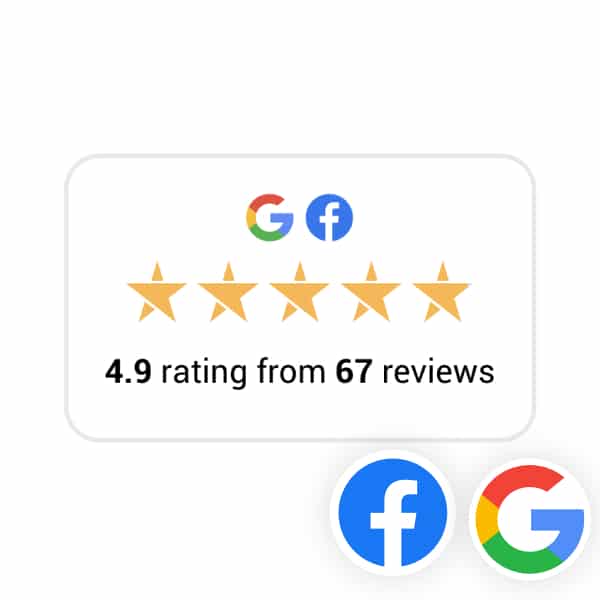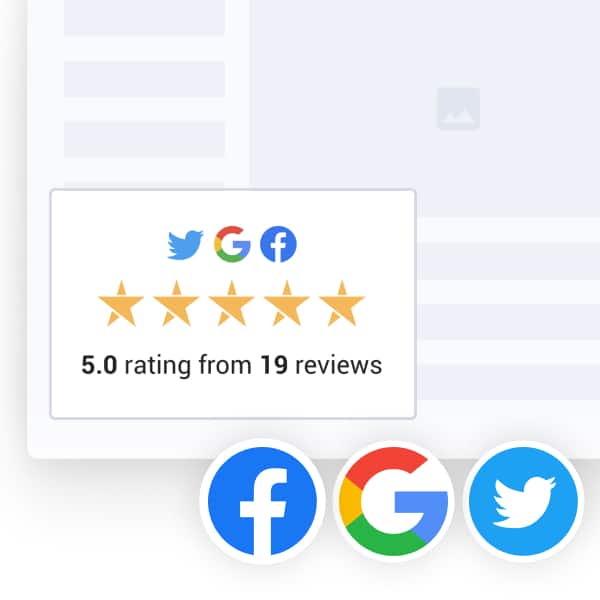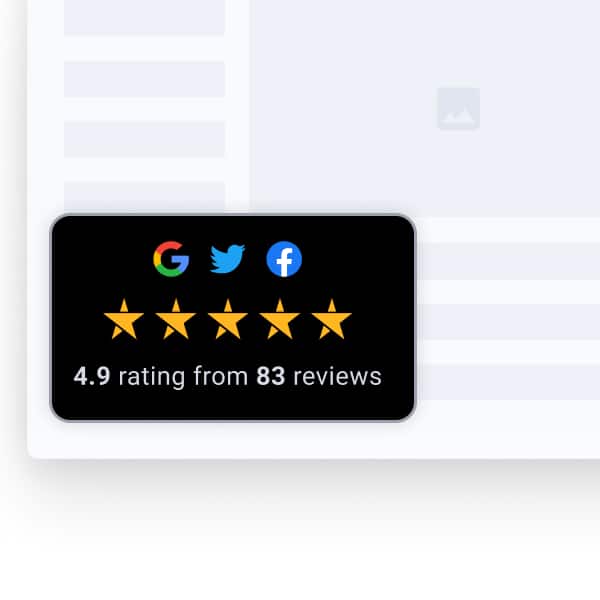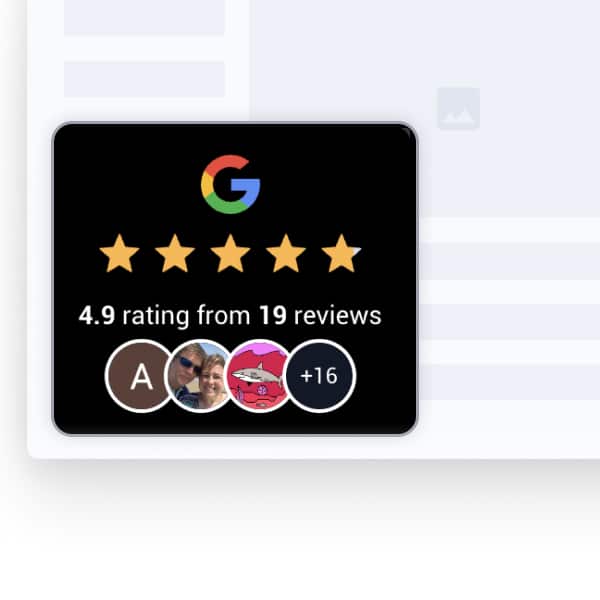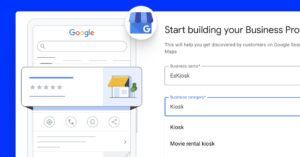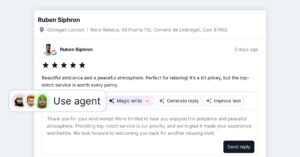Malédiction ou bénédiction ? Les évaluations ont le pouvoir de faire ou de défaire votre entreprise.
Il est temps de commencer à réfléchir à la manière dont vous pouvez gérer les critiques et anticiper les problèmes avant qu'ils ne surviennent.
Nous avons élaboré ce guide en 5 étapes qui vous aidera à garder le contrôle de vos avis et de votre entreprise.

Intégrer un widget PRO Google Reviews
Collecter automatiquement et intégrer les avis de Google et utilisez les outils de gestion des évaluations de l'IA pour libérer le potentiel de vente de votre site web.
POUR INFO: Vous pouvez automatiquement intégrer le widget Google reviews sur votre site web et afficher des commentaires authentiques générés par les utilisateurs, augmentant ainsi la confiance et augmentant les ventes. Essayez-le maintenant.
Qu'est-ce que la gestion des évaluations en ligne ?
La gestion des évaluations en ligne (également connue sous le nom de gestion de la réputation en ligne) est le processus de collecte, de génération, de réponse et de gestion des évaluations des clients des entreprises sur les plateformes d'évaluation.
Le développement d'une stratégie de gestion des évaluations est essentiel pour les entreprises locales afin d'établir une présence en ligne et de maintenir la satisfaction des clients à un niveau élevé.
87% des consommateurs ont lu des avis en ligne pour des entreprises locales avant de décider de faire un achat, ce qui est un chiffre important qui devrait vous inciter à vous lancer.
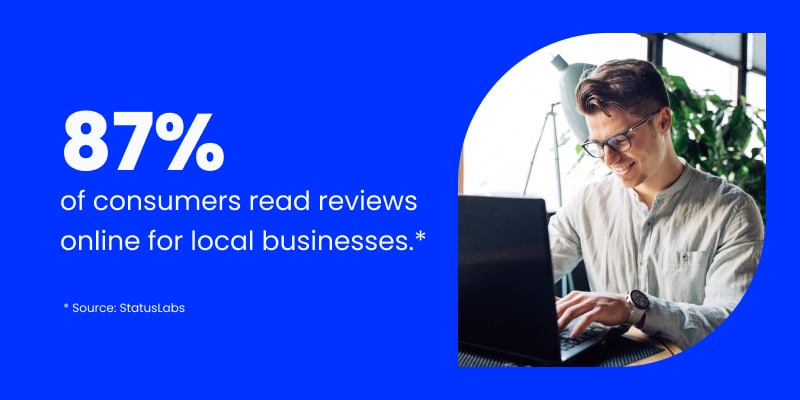
En savoir plus : Qu'est-ce qu'un agrégateur d'avis ??
Avantages de la gestion des évaluations en ligne
Disposer d'un système de gestion des évaluations en ligne est un aspect crucial du marketing numérique et des relations avec les clients. En voici les principaux avantages :
- Amélioration de la réputation et de la confiance: La gestion active des avis en ligne renforce la confiance des consommateurs en démontrant l'engagement de l'entreprise à satisfaire ses clients, ce qui a un impact positif sur la réputation de l'entreprise.
- Amélioration de la visibilité et du référencement: La gestion des avis peut conduire à un meilleur classement dans les moteurs de recherche, car ces derniers favorisent les entreprises ayant de nombreux avis de qualité, ce qui améliore leur visibilité en ligne.
- Des informations précieuses sur les clients: Les avis en ligne fournissent un retour d'information crucial aux clients, aidant les entreprises à comprendre leurs préférences et à améliorer leurs produits et services.
- Augmentation de l'engagement et de la fidélité des clients: Répondre aux commentaires permet d'établir des relations avec les clients, de les fidéliser et de les encourager à revenir sur le marché.
- Résolution des conflits et rétablissement des services: Le fait de répondre rapidement aux avis négatifs permet de résoudre les problèmes et d'améliorer la satisfaction des clients, ce qui témoigne de l'engagement de l'entreprise en faveur d'un service d'excellente qualité.
Gestion des commentaires et gestion de la réputation
La gestion des commentaires et la gestion de la réputation, bien que liées au domaine du marketing numérique et des relations avec les clients, se concentrent sur des domaines distincts. La gestion des commentaires traite spécifiquement les commentaires des clients sur des plateformes telles que Google, Yelp ou Amazon.
Il s'agit de surveiller ces examens, d'y répondre et d'encourager l'adoption de mesures d'incitation. retour d'information positif des clientsL'objectif principal est d'améliorer la qualité et la quantité de ces avis. Ces efforts ont un impact direct sur la façon dont les clients potentiels perçoivent une marque et peuvent améliorer le classement dans les moteurs de recherche.
D'autre part, la gestion de la réputation a une portée plus large, englobant l'image publique globale d'une marque ou d'un individu sur Internet. Si elle comprend la gestion des évaluations en ligne, elle s'étend également à la présence sur les médias sociaux, à la création de contenu, aux relations publiques et à tout contenu ou média en ligne susceptible d'influencer la perception du public.
L'objectif est ici de gérer les évaluations des entreprises et de façonner et maintenir de manière proactive une image de marque positive, de gérer le sentiment du public et d'atténuer la publicité négative sur toutes les plates-formes en ligne.
Par conséquent, si la gestion des critiques est un élément clé de la gestion de la réputation, cette dernière représente un ensemble plus large de stratégies visant à préserver et à améliorer l'image d'une marque ou d'un individu dans le paysage numérique dans son ensemble.
Les 5 étapes de la gestion de l'examen
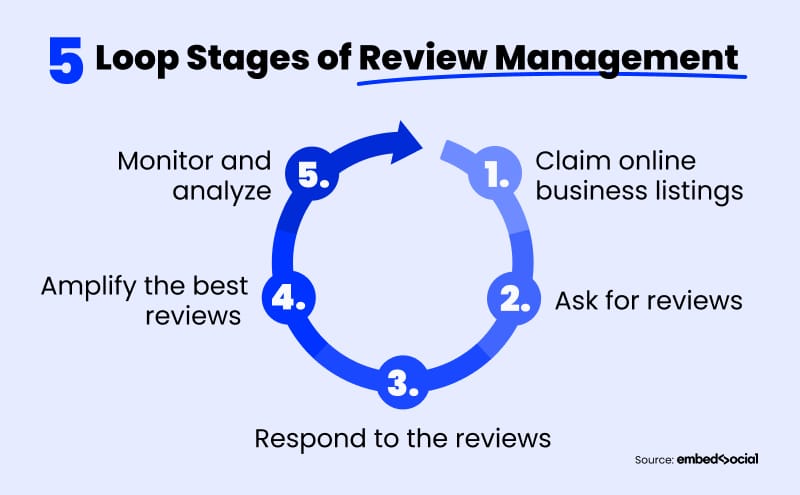
1. Réclamer des listes d'entreprises en ligne
La première étape du processus consiste à revendiquer vos inscriptions sur les sites d'évaluation en ligne les plus pertinents.
Commencez par analyser les sites d'évaluation qui sont importants pour votre niche.
Mais avant cela, vous devez savoir qu'il existe des sites d'évaluation générale qui sont INDISPENSABLES pour toute entreprise, petite ou grande. Il s'agit des sites suivants
- Google My Business - Le Fiche Google My Business est un outil essentiel. En fournissant des informations sur votre entreprise de cette manière, vous pouvez profiter de tous les avantages qui en découlent, tels que l'apparition sur les cartes ou dans les résultats de recherche lorsque les gens recherchent des entreprises comme la vôtre près de chez eux.
Si vous vous occupez suffisamment des commentaires en ligne, gérez les photos et publiez régulièrement des mises à jour, votre Google My Business peut devenir un nouveau canal d'acquisition de clients. - Facebook (et autres réseaux de médias sociaux) - Les médias sociaux sont un excellent moyen de faire connaître votre entreprise. Commentaires sur Facebook sont essentiels pour toutes les petites entreprises, car les clients potentiels visitent souvent les entreprises locales sur les médias sociaux avant de faire leurs achats. Aujourd'hui, il est plus courant que les gens laissent des recommandations publiquement plutôt que d'envoyer un message à l'entreprise, ce qui rend ces interactions beaucoup plus faciles et rapides.
- Votre site web - Votre site web est le seul endroit où vous pouvez exercer un contrôle total et afficher vos meilleurs commentaires. Vous pouvez consacrer une page aux témoignages pour montrer à quel point vous êtes fier de votre entreprise, ce qui donnera à vos clients potentiels l'envie de travailler avec quelqu'un qui se préoccupe autant de sa réputation que de la leur. Cela encouragera vos clients à laisser un retour d'information sur votre site web.
- Yelp- Yelp est un site web d'avis qui permet aux internautes de publier des avis sur des entreprises locales. L'avantage de Yelp est que vos clients satisfaits sont toujours en tête de votre flux d'avis. Au fil du temps, il est devenu l'un des sites les plus populaires pour les PME et vous devez prendre des mesures pour gérer leur profil sur ce site dès que possible.
Outre ces sites, il en existe des tonnes d'autres qui sont importants pour différents secteurs d'activité.
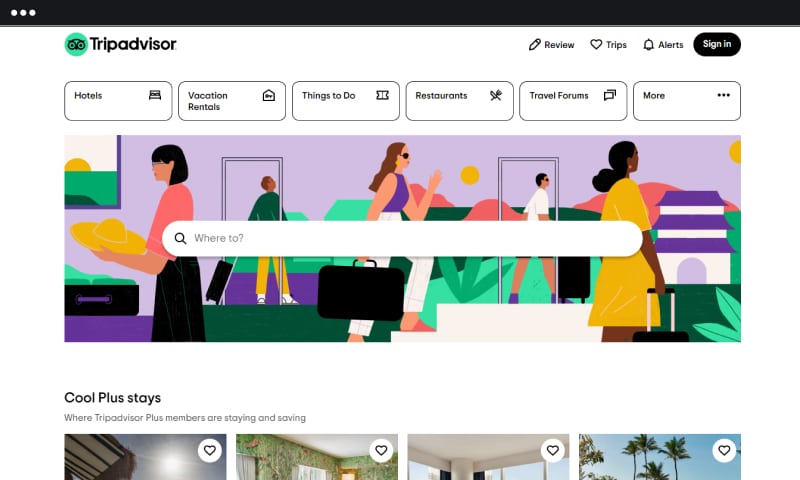
Par exemple, si vous travaillez dans le secteur des voyages et de l'hôtellerie, vous avez tout intérêt à figurer sur le site TripAdvisor et Réservation.
Si vous êtes propriétaire d'un restaurant, vous voudrez collecter commentaires des clients sur sites d'examen comme OpenTable, Zomato et Eat24.
Explorez la plupart des sites d'évaluation importants d'un secteur d'activité qui vous aideront à recueillir les commentaires de vos clients.
2. Demander des avis
Eh bien, ces avis positifs ne vont pas s'afficher d'eux-mêmes. Certains le feront peut-être, mais pour la majorité d'entre eux, vous devrez demander.
Avant de choisir le canal de demande de commentaires le plus approprié, assurez-vous de suivre les conseils suivants :
- Faciliter l'envoi d'un avis
- Minimiser le nombre de clics pour le processus
- Indiquer clairement la durée de l'opération
Maintenant que vous avez simplifié au maximum le processus, parlons des canaux de génération d'avis.
Il existe de nombreuses façons de demander à un client de donner son avis. En voici quelques-unes parmi les plus courantes :
- Demande par courriel - L'envoi d'un courrier électronique à vos clients satisfaits est un excellent moyen d'augmenter le nombre d'étoiles. Il vous suffit de disposer d'une base de contacts et de des modèles de demande d'examen personnalisables et vous êtes prêt à partir.
Il suffit d'inclure un lien d'évaluation ou un lien vers le formulaire de retour d'information dans l'e-mail, attendez votre évaluation cinq étoiles. - Demande par SMS – Demande d'avis par SMS est un moyen efficace de communiquer sans paraître intrusif, car les clients sont beaucoup plus réceptifs lorsque les messages leur parviennent en temps réel plutôt que d'attendre des jours ou des semaines pour les recevoir par courrier électronique.
- Demande sur votre site web - L'ajout d'une rubrique "laisser un avis" sur votre site web peut faire des miracles. Pour de nombreux utilisateurs, votre site web est un point de départ et d'arrivée dans le parcours de l'acheteur. Veillez donc à laisser un formulaire de collecte de commentaires sur votre site web.
- Demande sur le matériel imprimé - Vos efforts de marketing seront stimulés d'un cran et vous pourrez recueillir des témoignages de clients satisfaits même par impression. Les codes QR sont très pratiques à utiliser, de sorte que l'expérience de vos clients est améliorée lorsqu'ils soumettent leur témoignage directement sur la page de renvoi qui a été configurée avec le code. Pourquoi ne pas l'essayer ?
- Demander en personne - La communication en face à face ne se démode jamais. Profitez de toutes les occasions qui se présentent pour discuter avec vos clients actuels et nouveaux de leur expérience avec votre entreprise. C'est un excellent moyen d'instaurer la confiance et de vous assurer de nouvelles critiques.
En savoir plus : Comment demander plus d'avis Google ?
3. Répondre aux critiques
Le suivi des évaluations fait partie du processus de gestion. Il s'agit notamment de répondre aux commentaires laissés par vos clients.
Les gens aiment avoir l'impression que leur opinion compte. Vous devez leur montrer que vous vous souciez d'eux en reconnaissant les commentaires des clients et en répondant à leurs critiques.
Il existe généralement trois types d'avis : les avis positifs, les avis négatifs et les avis neutres. Chacun d'entre eux cherche à obtenir une réponse, mais l'approche est différente. Voyons comment vous pouvez gérer ces situations.
1. Répondre aux critiques positives - C'est formidable d'entendre que vos clients sont satisfaits de leur expérience avec votre entreprise. Ce sentiment de gratitude doit être réciproque en remerciant le client d'avoir pris un moment pour partager ses impressions sur ce que vous faites.
Vous venez de recevoir un commentaire 5 étoiles et il est temps de le remercier. Remercier est un moyen d'instaurer la confiance, la loyauté et l'authenticité, non seulement avec l'auteur de l'avis, mais aussi avec les clients potentiels.
2. Répondre aux critiques négatives - Les clients mécontents peuvent représenter un défi.
Un avis négatif n'est jamais une bonne expérience pour personne, mais c'est au moins l'occasion d'arranger les choses. L'utilisation de modèles de réponse aux mauvaises critiques et le fait de répondre avec soin et préoccupation montrent au client que vous vous souciez de lui, et même s'il a passé un mauvais moment une fois, vous voulez vous assurer que cela ne se reproduira pas à l'avenir. Ne négligez donc pas vos évaluations, car lorsque les clients constatent que leurs plaintes sont prises en compte dès que possible, la confiance s'installe beaucoup plus rapidement qu'en les ignorant ou en essayant d'éviter toute mention.
3. Répondre aux critiques neutres - Ce type de commentaires peut s'avérer délicat car, bien qu'ils ne semblent pas contenir beaucoup d'éloges à première vue, ils contiennent souvent des éléments des deux autres catégories en raison de signaux contradictoires. Par conséquent, lorsque vous recevez ce type de commentaires clients non exploitables, essayez d'axer votre réponse sur la partie positive et de reconnaître la partie négative. Essayez de comprendre et demandez plus de détails sur la manière dont vous pouvez améliorer leur expérience la prochaine fois.
Pour passer à la phase de réponse, vous devez surveiller les commentaires. La bonne nouvelle, c'est qu'il existe des outils de gestion des commentaires qui peuvent faciliter votre processus de gestion des commentaires.
En savoir plus : Comment répondre à un avis Google?
4. Amplifier les meilleurs commentaires
Vos commentaires positifs sont votre plus grand atout. Il vous suffit de savoir comment les amplifier.
Et ce n'est pas aussi compliqué que cela en a l'air. Vous pouvez utiliser un plateforme de gestion des examens et automatiser le processus. Voici comment vous pouvez intégrer vos évaluations dans votre stratégie de marketing et les utiliser pour campagnes de marketing et bien d'autres choses encore.
1. Afficher des widgets d'évaluation de sites web
La mise en valeur de vos meilleurs commentaires influencera considérablement votre réputation. Vous pouvez intégrer widgets d'évaluation sur votre site web de différentes manières.
- Affichez les commentaires sur votre page "À propos de nous".
- Placez-les dans un en-tête sur votre page d'accueil
- Créer une page dédiée aux critiques et aux témoignages
- Afficher les avis sur les produits sur les pages produits
- Créez un carrousel de vos favoris
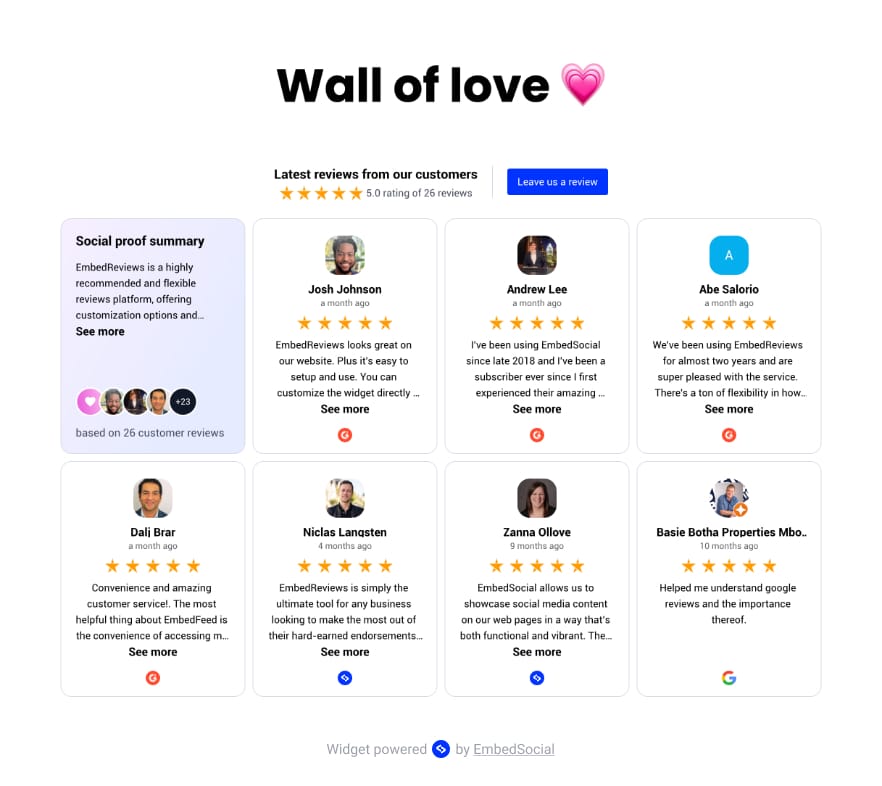
2. Intégrer un badge d'évaluation
Poursuivez et afficher un badge d'évaluation de vos avis Google et Facebook sur votre site web. Cela fera ressortir votre note globale et renforcera la confiance des clients et des visiteurs du site web. Choisissez les meilleurs widgets d'évaluation pour votre site web :
3. Utiliser des témoignages de clients dans les publicités
Preuve sociale est l'un des moyens les plus efficaces d'influencer les décisions des clients potentiels. Les témoignages sont un excellent moyen pour vous de montrer que vous avez des clients satisfaits et d'en gagner de nouveaux grâce à publicités sur les médias sociauxcomme Facebook.
5. Contrôler et analyser

Il est très important de surveiller la réputation en ligne de votre entreprise. Il peut être difficile pour vous et le reste de votre équipe de rester au courant de tout ce qui se passe lorsque tant de gens en parlent, mais voici une liste de choses qui devraient toujours attirer votre attention :
- Votre classement par étoiles- Les entreprises les plus prospères ont de nombreux clients satisfaits et de bonnes critiques, alors ne vous contentez pas d'une note inférieure à 4 étoiles. N'oubliez pas que votre classement par étoiles est la première chose que les gens voient lorsqu'ils effectuent une recherche en ligne et qu'il détermine souvent si vous obtiendrez plus de clients ou non.
- Mentions sur le web - Vous devez surveiller la réputation de votre marque sur les médias sociaux. Il existe de nombreux outils en ligne qui peuvent fournir des informations sur les mentions de vous et/ou de votre entreprise, mais il est également important de prêter attention au contexte. Au fil du temps, ces informations vous aideront à savoir ce que les gens pensent de votre marque.
- Votre classement dans les SERP - Dans le domaine de l'internet, le référencement est un outil puissant. Il est évident que les entreprises qui se trouvent en tête des moteurs de recherche reçoivent le plus de trafic et de conversions - c'est pourquoi votre classement dans les SERP est si important ! Voici un moyen simple de stimuler votre référencement à l'aide d'avis. Les Code du schéma permet de présenter des étoiles d'évaluation agrégées dans les résultats de recherche Google, ce qui les rend légèrement plus pertinents que d'autres sites ne disposant pas de ces informations.
Maintenant que nous avons franchi toutes les étapes, voici votre liste de contrôle.
Téléchargez-le et laissez-le vous aider à suivre votre stratégie de gestion des révisions. ?
En savoir plus : Les meilleurs services de gestion de la réputation en ligne
Quelles sont les caractéristiques de notre logiciel de gestion des examens ?
Logiciel de gestion des examens offre généralement une gamme de fonctionnalités conçues pour rationaliser et améliorer le processus de gestion des avis en ligne. Les principales caractéristiques sont souvent les suivantes
Agrégation
Collecte les avis de différentes plateformes (comme Google, Facebook, Airbnb Reviews, Twitter Reviews, etc.) et les centralise dans un tableau de bord pour en faciliter le suivi et la gestion. Cela permet de gagner du temps et de s'assurer qu'aucun avis n'est oublié.
Gestion des réponses
Permet aux utilisateurs de répondre aux commentaires directement à partir du logiciel. Certaines plateformes peuvent proposer des réponses types ou automatisées pour plus d'efficacité, mais les réponses personnalisées sont généralement plus efficaces.
Rapports et analyses
Offre des informations sur les tendances, le volume d'avis, les évaluations au fil du temps, etc., qui peuvent s'avérer essentielles pour comprendre l'impact des avis sur l'entreprise et prendre des décisions en connaissance de cause.
Intégration avec d'autres logiciels
Il s'intègre souvent aux systèmes CRM (gestion de la relation client), aux plateformes de médias sociaux et à d'autres outils commerciaux pour rationaliser les flux de travail et relier la gestion des révisions à des stratégies plus larges de marketing et de service à la clientèle.
Tableaux de bord et filtres personnalisables
Fournit des interfaces personnalisables et des options de filtrage pour trier, gérer et hiérarchiser les avis en fonction de différents critères tels que le nombre d'étoiles, la plateforme, la date, etc.
Meilleure stratégie de gestion des évaluations des clients
Un outil efficace stratégie de gestion des commentaires en ligne est essentiel pour maintenir une présence positive en ligne et gagner la confiance des clients. Voici quelques stratégies clés :
Réponses rapides et personnalisées
Répondez rapidement et personnellement aux avis positifs et négatifs pour montrer aux clients que leurs commentaires sont importants et que votre entreprise s'engage à fournir un service exceptionnel. Des réponses personnalisées, plutôt que des réponses génériques, permettent de rendre positives les expériences négatives et de renforcer les bonnes impressions.
Encourager les commentaires des clients
Sollicitez activement les avis des clients après l'achat ou l'interaction par le biais d'e-mails de suivi, d'invites sur le site web ou au point de vente. Un plus grand nombre d'avis permet de mieux connaître les clients et d'améliorer le référencement et la visibilité en ligne, car de nombreuses plateformes favorisent les entreprises dont les commentaires sont plus fréquents.
Tirer parti de manière constructive du retour d'information négatif
Utilisez les critiques négatives comme une occasion de reconnaître les problèmes, de proposer des solutions ou des compensations le cas échéant, et de mettre en œuvre des changements sur la base des commentaires. Cette approche peut atténuer les effets des mauvaises critiques et, en montrant votre volonté d'amélioration, peut réellement renforcer votre crédibilité et la fidélité de vos clients.
Contrôler et gérer régulièrement les examens
Suivez régulièrement les évaluations sur les différentes plateformes pour rester informé des sentiments et des problèmes des clients. L'utilisation d'outils de gestion des avis peut faciliter le suivi, fournir des analyses et des alertes en temps opportun. Cette vigilance permet aux entreprises de réagir rapidement, de gérer efficacement les problèmes potentiels et d'évaluer avec précision la satisfaction globale des clients, garantissant ainsi une approche commerciale axée sur le client.
Le coût de la (non) mauvaise gestion de la réputation
Il n'est pas surprenant qu'une entreprise ayant une mauvaise réputation ait du mal à attirer de nouveaux clients, mais quel est le coût réel de ce manque de confiance ?
Selon un étude récente94% déclarent qu'un avis négatif en ligne les a convaincus d'éviter une entreprise.
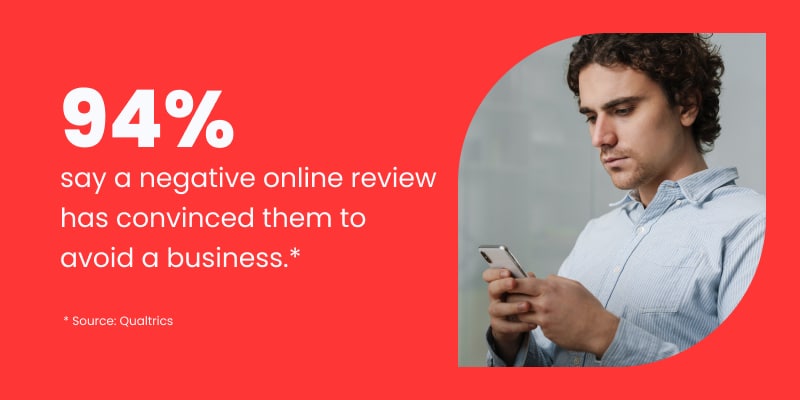
C'est d'autant plus vrai avec la crise Covid, qui a accéléré l'importance de l'expérience client et a stimulé la croissance de l'entreprise. tendances en matière de réputation en ligne que chaque entreprise doit employer si elle veut survivre.
Une mauvaise réputation nuit fortement au marketing et aux ventes. Par conséquent, plus vous avez d'avis négatifs, plus vous perdez de ventes.
Votre réputation en ligne est cruciale pour le succès de votre entreprise. Une mauvaise réputation n'a pas que des répercussions sur les ventes : une presse négative peut entraîner une crise de rétention des employés et une augmentation des coûts de recrutement.
Êtes-vous prêts ?
Maintenant que vous êtes arrivé au bout, vous avez tout ce qu'il vous faut pour établir une stratégie de gestion des critiques et vous forger une excellente réputation : un plan en boucle de gestion des critiques pour vous guider tout au long du processus, une liste de contrôle à suivre et un plan d'action de gestion des critiques pour vous aider à atteindre vos objectifs. plateforme de gestion des examens pour faire le gros du travail à votre place.
En fin de compte, votre marque ne vaut que ce que vaut sa réputation. Vous devez toujours en être conscient pour qu'un produit et un service de qualité vous représentent bien.
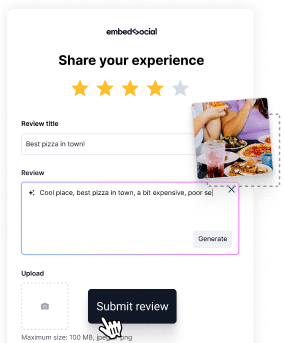
Recueillir des avis, des commentaires et afficher des widgets de témoignages à grande échelle!
Utiliser le formulaire complet logiciel de gestion des examens de générer et d'afficher des informations sur Google widgets d'évaluation sur votre site web.
